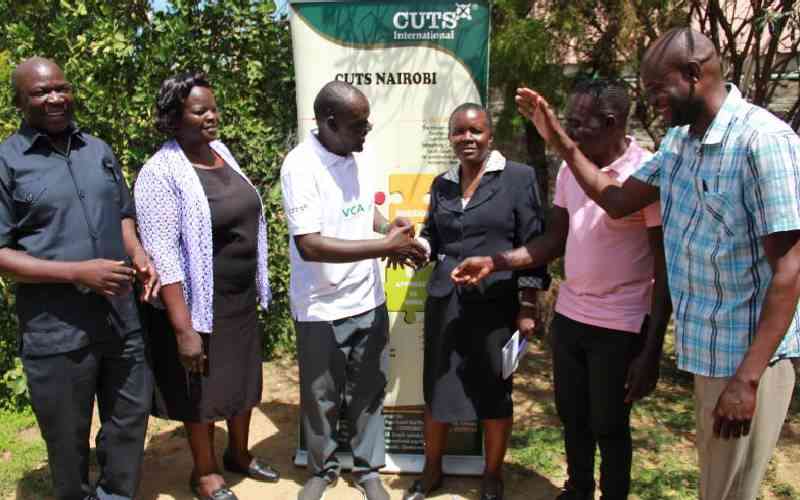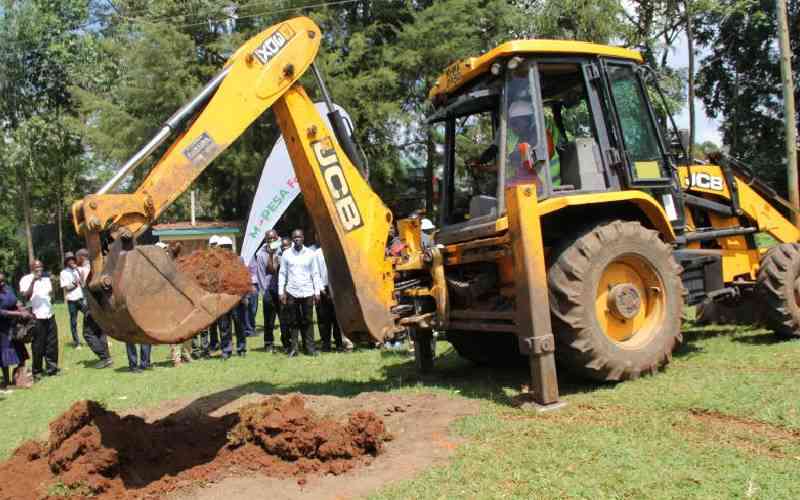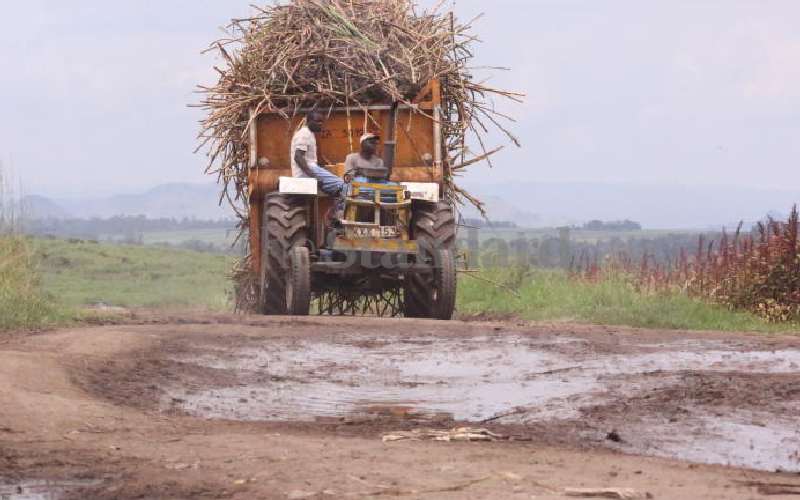
A tractor pulls a trailer loaded with sugarcane along a muddy section of the Chemelil-Amu Road in Muhoroni Constituency, Kisumu County. [Collins Oduor, Standard]
For Jared Otieno, any sign of rainfall is a reminder that he needs to get home very fast.
On several occasions during the rainy season, he has had to spend nights at Chemelil or Awasi towns because he cannot access his home in Bad Oseng, Muhoroni sub-County, which is about 10 kilometres away.
When it rains, the access roads, covered by black cotton soil, are no-go zones, and many times his vehicle gets stuck in the mud.
Trucks transporting cane from the plantations to the mills have worsened the situation.
The state of the roads partly contributed to Otieno abandoning sugarcane farming over a decade ago.
His 80-acre parcel of land now lies idle.
“The roads were last fixed in the 1960s,” said Otieno.
Switch off mill
At Chemelil Sugar Company, the machines are silent as operators wait for more cane.
Gabriel Nyangweso, the managing director says they usually switch off the mill until cane is brought.
Chemelil is one of the three sugar mills in the sugar belt that collects levies, which amount to one per cent of the cost of cane milled.
According to Nyangweso, the company collects about Sh300,000 monthly from farmers.
“Out of this, about Sh180,000 goes to Kisumu County Government, while the rest goes to Nandi County since it is a major contributor to the cane we crush,” said Nyangweso.
The county governments are expected to use the monies, alongside their infrastructure allocation, to maintain the roads in the farming zones.
Previously, the factories would collect the money and retain 85 per cent for road maintenance, and release the rest to the local authorities.
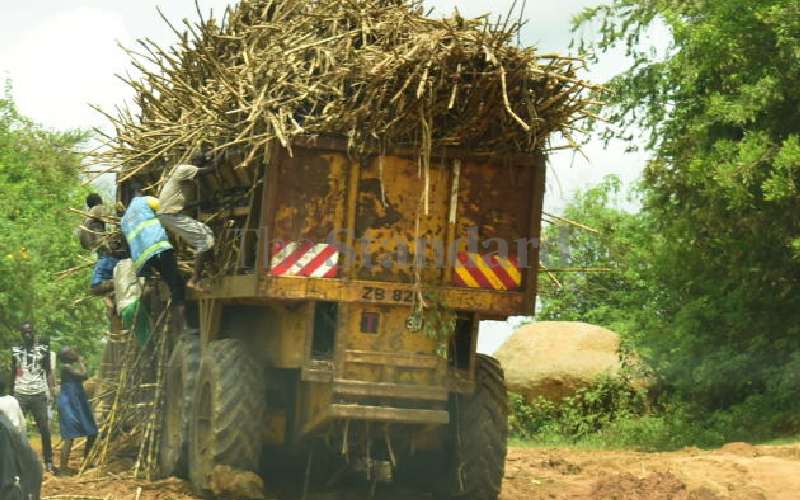
Tractor pulling trailer loaded with sugarcane in Butere, Kakamega County. [Mumo Munuve, Standard]
However, after devolution, the law changed and the levies are remitted to the county governments for maintaining the roads.
“Once in a while, we work on sections of the roads if we want to get some cane from an area to the factory, but this is not sustainable,” added Nyangweso.
Several roads are in a bad state, with farmers decrying the heavy losses they incur while delivering cane to the factories.
Evans Mbayi, a sugarcane farmer and a village elder at God Abuoro, says he uses the Chemelil-Kopon-Tamu road to access Chemelil Sugar Factory.
“At times, you may load 15 tonnes of cane, and only half of it reaches the factory, that is if you are lucky that the truck does not overturn or get stuck in the mud,” he said.
Currently, farmers earn Sh3,833 per tonne of cane delivered to the factory, and they spend between Sh462 and Sh950 to transport a tonne, depending on the distance to the mill.
“We pay workers Sh4,000 to load a 15 to 20-tonne truck, and another Sh1,000 goes to the driver. If the truck overturns or gets stuck, you have to get another one, and pay again,” he said.
Work going on
However, Daniel Okia, the County chief officer for roads, said the county government has completed maintenance of 30 kilometres of roads in the sugar belt, adding that work on other roads is still going on.
He said between 2019 and 2021, the county received Sh18.1 million as cess, which was effectively ploughed back.
“Kisumu sugar belt region has a 400-km road network. All the two levels of government have roles they play in the maintenance of these roads,” he said.
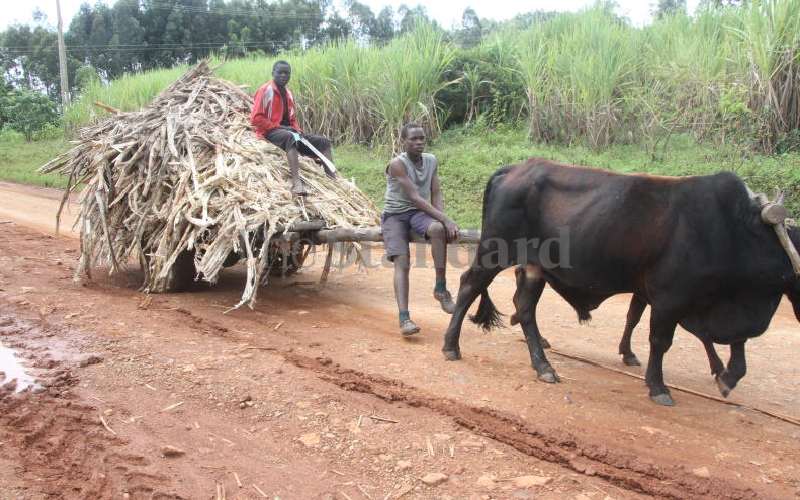
Sugarcane farmers hauling bagasse in Dede centre, Awendo sub-county. May 26, 2021. [Caleb Kingwara, Standard]
He said the planned construction of 63km Mamboleo-Miwani-Chemelil-Muhoroni to Kipsitet junction would open up the sugar belt region thus ensuring accessibility and delivery of services.
Tedman Maina, a former surveyor at Chemelil Sugar Company who planned some roads in Chemelil and Muhoroni areas, still has the map of Miwani, Chemelil and Muhoroni.
“Apart from the poor state of the roads, there is a lot of encroachment which has seen the roads become narrow,” he said.
The poor state of roads has affected learning institutions too.
A school such as Achego Girls’ High School, with 1,400 students, is almost inaccessible.
 The Standard Group Plc is a multi-media organization with investments in media platforms spanning newspaper print
operations, television, radio broadcasting, digital and online services. The Standard Group is recognized as a
leading multi-media house in Kenya with a key influence in matters of national and international interest.
The Standard Group Plc is a multi-media organization with investments in media platforms spanning newspaper print
operations, television, radio broadcasting, digital and online services. The Standard Group is recognized as a
leading multi-media house in Kenya with a key influence in matters of national and international interest.



